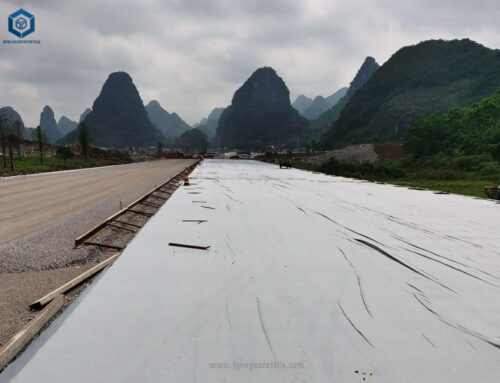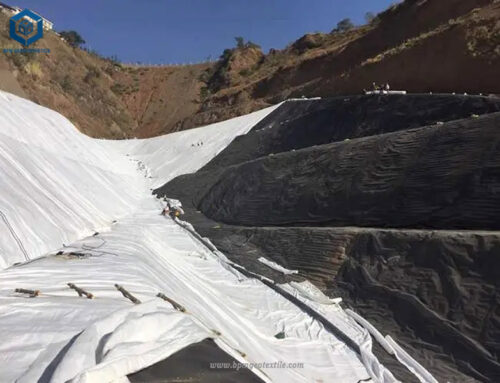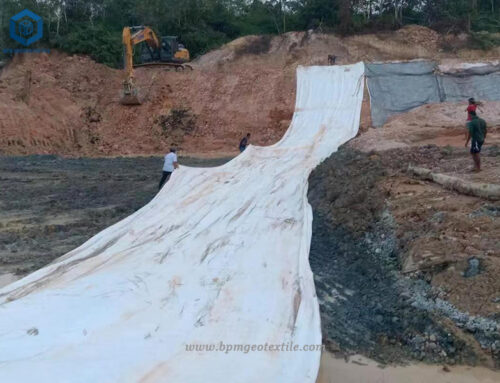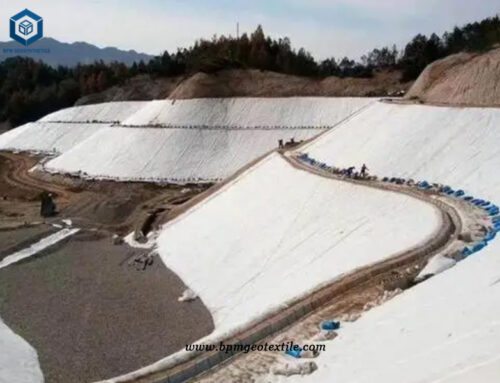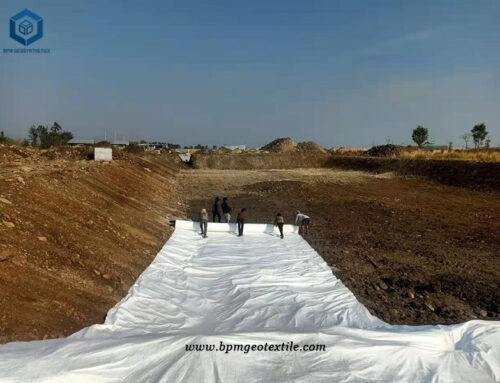Spunbond nonwoven geotextile, also knwon as nonwoven spunbond geotextile, is the widely used geotextile fabric which offers superior tensile strength and tear resistance compared to needle-punched nonwovens. The nonwoven spunbond geotextile is robust construction and more resistant to installation damage, ensuring a longer lifespan. Spunbond nonwoven geotextile outperforms needle-punch alternatives when it comes to withstanding the stresses of installation, reducing the risk of tearing or weakening. This enhanced durability translates into a prolonged service life for geotextile applications. Spunbond geotextile provides reliable support and reinforcement, maintaining their strength and integrity over time.
1. What Is Spunbond Nonwoven Geotextile?
Spunbond nonwoven geotextile is a specialized material produced through the spunbonding manufacturing method. This process involves extruding filaments onto a collection belt and bonding them using heated rolls, resulting in a smoother, stiffer product with enhanced strength and reduced pore size. Typically appearing in gray color, spunbond nonwoven geotextiles consist of thermally bonded continuous polypropylene filaments. During production, thousands of fine filaments are oriented and bonded together, creating a sheet with unique properties and consistent quality compared to other geotextiles.
The production of spunbond nonwoven geotextile involves an integrated process of web formation, fiber spinning, and bonding, eliminating intermediate steps and streamlining production for increased efficiency and cost-effectiveness. This innovative fabric type has gained rapid popularity in recent years due to its exceptional properties and efficient manufacturing process, holding a significant share in the realm of nonwoven fabric production across various industries.
Spunbond nonwoven geotextile has high tensile strength, puncture resistance, and durability, spunbond nonwoven geotextiles find widespread application in civil engineering and construction projects. These geotextiles play crucial roles in soil stabilization, erosion control, drainage systems, filtration processes, and soil layer separation. With superior physical and mechanical characteristics, including lightweight construction, ease of installation, and resistance to UV degradation and chemicals, spunbond nonwoven geotextiles offer reliable reinforcement and protection in diverse geotechnical applications, ensuring long-term performance in demanding environments.
2. What Are The Benefits of Spunbond Nonwoven Geotextile?
Spunbond nonwoven geotextile deliver more tensile strength and tear strength than most needle-punched nonwovens for endurance in heavy load applications. Spunbond geotextiles outperform most needle-punch nonwovens in resisting installation damage, which results in a longer service life.
- High strength, puncture resistance;
- Long period isolation, good resistance to frost, acid, corrosion, anti-microbial, anti-aging;
- Excellent permeability, filtration, protection Soil, played isolation, drainage filters, protective role;
- Excellent protection performance: product the waterproof layer from the mechanical damage.
- Long period isolation, good resistance to frost.
- Low cost, excellent price, simple construction, easy to use.
- Moisture-proof, breathable, flexible, light weight,
- Non-combustion-supporting,
- Non-toxic non-irritating,
- low cost and can be recycled reuse, etc.
Spunbond nonwoven geotextile is the widely used geotextile fabric mainly made of PP or PET short fiber and is produced by non-woven process. The geotextile fabric has functions of isolation, filtration, drainage, reinforcement, protection and maintenance, etc. Spunbond nonwoven geotextile is widely used in dam and water conservancy, hydro power, roads, railways, ports, airports, sports venues, tunnels, beach coating, cofferdams, environmental protection and other civil engineering fields. The spunbond nonwoven geotextile fabric has the following functions.
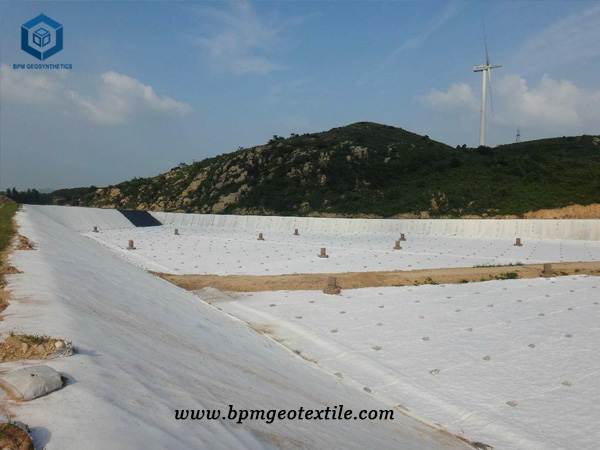
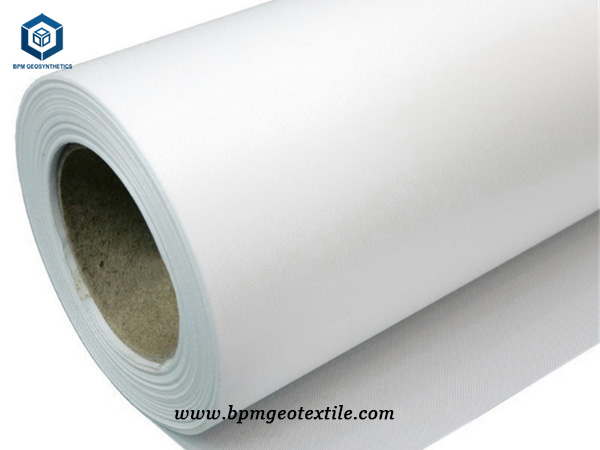
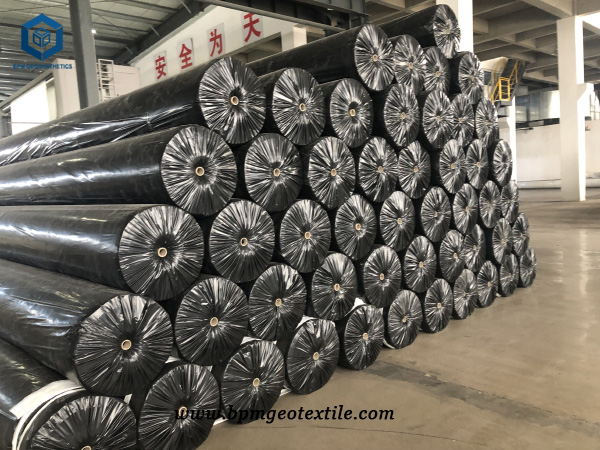
2. What Are The Benefits of Spunbond Nonwoven Geotextile?
Spunbond nonwoven geotextiles offer a range of benefits for various applications:
2.1 High Strength and Puncture Resistance
Spunbond nonwoven geotextiles provide superior tensile strength and tear resistance compared to most needle-punched nonwovens. This makes them suitable for enduring heavy load applications and helps prevent damage or failure.
2.2 Durability and Long Service Life
These geotextiles outperform needle-punch nonwovens in resisting installation damage, resulting in a longer service life. They maintain their structural integrity and performance over extended periods, reducing the need for frequent replacements or repairs.
2.3 Resistance to Environmental Factors
Spunbond nonwoven geotextiles exhibit good resistance to frost, acid, corrosion, and microbial growth. They can withstand challenging environmental conditions, ensuring their effectiveness and longevity in various settings.
2.4 Excellent Permeability and Filtration
These geotextiles have excellent permeability, allowing water to pass through while effectively filtering soil particles. They play a critical role in soil protection, isolation, drainage, and filtration, maintaining the stability and integrity of the surrounding environment.
2.5 Protection Performance
Spunbond nonwoven geotextiles provide excellent protection for underlying waterproof layers. They act as a mechanical barrier, shielding the waterproof layer from potential damage caused by external factors such as mechanical stress or abrasion.
2.6 Cost-Effectiveness and Ease of Use
Spunbond nonwoven geotextiles are cost-effective compared to other options. They offer an excellent price-performance ratio and are easy to install and work with, making them a convenient choice for construction projects.
2.7 Moisture-Proof, Breathable, and Lightweight
These geotextiles are moisture-proof while remaining breathable. They allow for proper air circulation and prevent the accumulation of moisture, promoting a healthy environment. Additionally, their lightweight nature simplifies transportation and handling during installation.
2.8 Non-Combustible and Non-Toxic
Spunbond nonwoven geotextiles are non-combustible, reducing the risk of fire hazards. They are also non-toxic and non-irritating, ensuring safety during installation and use.
Spunbond nonwoven geotextiles offer high strength, puncture resistance, durability, and resistance to environmental factors. They provide excellent permeability, filtration, and protection performance. With their cost-effectiveness, ease of use, and non-toxic properties, spunbond nonwoven geotextiles are a reliable and versatile choice for a wide range of geotechnical applications.
3. Is Spunbond Nonwoven Geotextilec Waterproof?
Spunbond nonwoven geotextile is not inherently waterproof. Spunbond nonwoven geotextiles are designed to allow water to pass through them while effectively filtering soil particles. However, they can contribute to the overall waterproofing system by providing protection to underlying waterproof layers. Spunbond nonwoven geotextiles act as a mechanical barrier, shielding the waterproof layer from potential damage caused by external factors such as mechanical stress or abrasion. This helps to maintain the integrity and effectiveness of the waterproofing system.
4. Case Study Of Spunbond Nonwoven Fabric Thailand for Dam Project
We received an inquiry from our client in Thailand regarding the use of spunbond nonwoven geotextile for a dam project. The client specifically requested PET material for the geotextile. In response, we provided them with technical data on PET filament spunbond nonwoven geotextile as a reference.
PET filament spunbond nonwoven geotextile is well-suited for dam projects, as it can be applied to the surface of the dam to provide effective anti-scouring protection. By preventing significant damage to the soil layers of the dam caused by erosion, it helps to safeguard the structure from potential collapse. This protective measure enhances the longevity of the dam and reduces the risk of future issues.
After reviewing the information provided, the client decided to proceed with a 210g/m² PET filament spunbond nonwoven geotextile and subsequently placed an order with us.
By choosing PET filament spunbond nonwoven geotextile for their dam project, the client will benefit from its durability, strength, and resistance to environmental factors. The geotextile will serve as a reliable barrier against scouring, ensuring the stability and integrity of the dam over time.
5. Specifications of Spunbond Nonwoven Fabric for Dam Project in Thailand
- Order quantity –44660 square meters
- Geotextile fabric thickness – 210 g/㎡
- Each roll size – 8m*100m
- One 20GP container
6. About BPM Geosynthetics
BPM has been manufacturing and supplying many types of effective and states of the art geotextile, geomembranes, and other geosynthetics to over 81 countries. Our geosynthetic products are widely used across a variety of industries including waste containment, water containment, aquaculture, industrial project, energy project and mining projects, etc.

